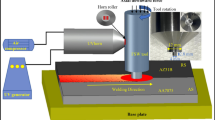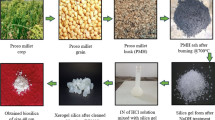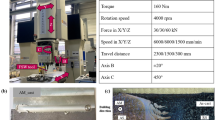Abstract
Friction Stir Spot Welding (FSSW) is successfully applied for the joining of sandwich sheets with a polymeric core at varying dwell times. The mechanical performance of the joint is evaluated at various loading conditions. The joint performance of the sandwich sheet is significantly affected by the dwell time in the lap shear test and peel test, while a poor relationship exists between the dwell time and joint performance in the cross-tension test and uniaxial tension test. On the joint cross-section, macrostructure, microstructure, microhardness, and temperature are evaluated. A logical relation is established between these indexes and dwell time. A finite element model is developed to visualize and understand the material flow in the FSSW process of the sandwich sheet and to justify the accommodation of plasticized material into the core layer. The failure modes are also investigated via experiments and simulations, which matched with each other. The failure modes mainly depend upon the hook geometry.

























Similar content being viewed by others
Availability of data and material (data transparency)
Provided in the supplementary material.
Code availability (software application or custom code)
NA
References
Tanco JS, Nielsen CV, Chergui A, Zhang W, Bay N (2015) Weld nugget formation in resistance spot welding of new lightweight sandwich material. Int J Adv Manuf Technol 80:1137–1147. https://doi.org/10.1007/s00170-015-7108-0
Pickin CG, Young K, Tuersley I (2007) Joining of lightweight sandwich sheets to aluminium using self-pierce riveting. Mater Des 28:2361–2365. https://doi.org/10.1016/j.matdes.2006.08.003
Ozlati A, Movahedi M, Tamizi M, Tartifzadeh Z, Alipour S (2019) An alternative additive manufacturing-based joining method to make metal/polymer hybrid structures. J Manuf Process 45:217–226. https://doi.org/10.1016/j.jmapro.2019.07.002
Mazda (2003) Mazda develops world’s first aluminum joining technology using friction heat. In: Maz. Backnumber. https://www2.mazda.com/en/publicity/release/archive/2003/200302/0227e.html
Yan Y, Shen Y, Lei H, Zhuang J (2019) Influence of welding parameters and tool geometry on the morphology and mechanical performance of ABS friction stir spot welds. Int J Adv Manuf Technol 103:2319–2330. https://doi.org/10.1007/s00170-019-03703-4
Pabandi HK, Movahedi M, Kokabi AH (2017) A new refill friction spot welding process for aluminum/polymer composite hybrid structures. Compos Struct 174:59–69. https://doi.org/10.1016/j.compstruct.2017.04.053
Uematsu Y, Tokaji K (2009) Comparison of fatigue behaviour between resistance spot and friction stir spot welded aluminium alloy sheets. Sci Technol Weld Join 14:62–71. https://doi.org/10.1179/136217108X338908
de la Parte MP, Azofra JC, Fals HDC, Roca AS, Orozco MCS, Macías EJ (2019) A new way to predict the mechanical properties of friction stir spot welding for Al-Cu joints by energy analysis of the vibration signals. Int J Adv Manuf Technol 105:1823–1834. https://doi.org/10.1007/s00170-019-04396-5
Colmenero AN, Orozco MS, Macías EJ, Fernández JB, Muro JCSD, Fals HC, Roca AS (2019) Optimization of friction stir spot welding process parameters for Al-Cu dissimilar joints using the energy of the vibration signals. Int J Adv Manuf Technol 100:2795–2802. https://doi.org/10.1007/s00170-018-2779-y
Rana PK, Narayanan RG, Kailas SV (2018) Effect of rotational speed on friction stir spot welding of AA5052-H32/HDPE/AA5052-H32 sandwich sheets. J Mater Process Technol 252:511–523. https://doi.org/10.1016/j.jmatprotec.2017.10.016
Rana PK, Narayanan RG, Kailas SV (2019) Friction stir spot welding of AA5052-H32/HDPE/AA5052-H32 sandwich sheets at varying plunge speeds. Thin-Walled Struct 138:415–429. https://doi.org/10.1016/j.tws.2019.02.016
Rana PK, Narayanan RG, Kailas S V. (2019) Influence of tool plunge depth during friction stir spot welding of AA5052-H32/HDPE/AA5052-H32 sandwich sheets. In: Dixit, S U., Narayanan GR (ed) Strengthening and joining by plastic deformation. Lecture Notes on Multidisciplinary Industrial Engineering. Springer, Singapore, pp. 95–121
Raikoty H, Ahmed I, Talia GE (2005) High speed friction stir welding: a computational and experimental study. Proc ASME Summer Heat Transf Conf 3:431–436. https://doi.org/10.1115/HT2005-72833
Genna S, Leone C, Tagliaferri V (2017) Characterization of laser beam transmission through a High Density Polyethylene (HDPE) plate. Opt Laser Technol 88:61–67. https://doi.org/10.1016/j.optlastec.2016.08.010
Chu Q, Yang XW, Li WY, Vairis A, Wang WB (2018) Numerical analysis of material flow in the probeless friction stir spot welding based on Coupled Eulerian-Lagrangian approach. J Manuf Process 36:181–187. https://doi.org/10.1016/j.jmapro.2018.10.013
Aval HJ, Serajzadeh S, Kokabi AH (2011) Theoretical and experimental investigation into friction stir welding of AA 5086. Int J Adv Manuf Technol 52:531–544. https://doi.org/10.1007/s00170-010-2752-x
Zhu XK, Chao YJ (2002) Effects of temperature-dependent material properties on welding simulation. Comput Struct 80:967–976. https://doi.org/10.1016/S0045-7949(02)00040-8
Bentouhami A (2018) Experimental and numerical analysis of behavior of honeycomb sandwiches panels subjected to impact. Ferhat Abbas University, Setif
Khalajmasoumi M, Koloor SSR, Arefnia A, Ibrahim IS, Yatim JM (2012) Hyperelastic analysis of high density polyethylene under monotonic compressive load. Appl Mech Mater 229–231:309–313. https://doi.org/10.4028/www.scientific.net/AMM.229-231.309
Zhang C, Moore ID (1997) Nonlinear mechanical response of high density polyethylene. Part I: experimental investigation and model evaluation. Polym Eng Sci 37:404–413. https://doi.org/10.1002/pen.11683
dos Santos WN, de Sousa JA, Gregorio R (2013) Thermal conductivity behaviour of polymers around glass transition and crystalline melting temperatures. Polym Test 32:987–994. https://doi.org/10.1016/j.polymertesting.2013.05.007
Ramin L, Assadi MHN, Sahajwalla V (2014) High-density polyethylene degradation into low molecular weight gases at 1823K: an atomistic simulation. J Anal Appl Pyrolysis 110:318–321. https://doi.org/10.1016/j.jaap.2014.09.022
Levanger H (2012) Simulating ductile fracture in steel using the finite element method: comparison of two models for describing local instability due to ductile fracture. University of Oslo Norway
Awang M (2007) Simulation of friction stir spot welding (FSSW) process: study of friction phenomena. College of Engineering and Mineral Resources at West Virginia University
Kiran R, Khandelwal K (2014) A triaxiality and lode parameter dependent ductile fracture criterion. Eng Fract Mech 128:121–138. https://doi.org/10.1016/j.engfracmech.2014.07.010
Danijela Z, Aleksandar S, Aleksandar G (2013) Crack growth analysis in friction stir welded joint zones using extended finite element method. Struct Integr Life 13:179–188
Lin Y-C, Liu J, Lin B-Y et al (2012) Effects of process parameters on strength of Mg alloy AZ61 friction stir spot welds. Mater Des 35:350–357. https://doi.org/10.1016/j.matdes.2011.08.050
Yin YH, Sun N, North TH, Hu SS (2010) Influence of tool design on mechanical properties of AZ31 friction stir spot welds. Sci Technol Weld Join 15:81–86. https://doi.org/10.1179/136217109X12489665059384
Badarinarayan H, Shi Y, Li X, Okamoto K (2009) Effect of tool geometry on hook formation and static strength of friction stir spot welded aluminum 5754-O sheets. Int J Mach Tools Manuf 49:814–823. https://doi.org/10.1016/j.ijmachtools.2009.06.001
Rana PK, Narayanan RG, Kailas S V. (2018) Thermal and mechanical response in FSSW of sandwich sheets at different dwell periods. In: proceedings of National Conference on Advanced Materials, Manufacturing and Metrology (NCAMMM – 2018). Durgapur, pp 235–240
Li G, Zhou L, Zhou W, Song X, Huang Y (2019) Influence of dwell time on microstructure evolution and mechanical properties of dissimilar friction stir spot welded aluminum–copper metals. J Mater Res Technol 8:2613–2624. https://doi.org/10.1016/j.jmrt.2019.02.015
Bakavos D, Prangnell PB (2009) Effect of reduced or zero pin length and anvil insulation on friction stir spot welding thin gauge 6111 automotive sheet. Sci Technol Weld Join 14:443–456. https://doi.org/10.1179/136217109X427494
Capiati NJ, Porter RS (1975) The concept of one polymer composites modelled with high density polyethylene. J Mater Sci 10:1671–1677. https://doi.org/10.1007/BF00554928
Sakai T, Jonas JJ (1984) Overview no. 35 dynamic recrystallization: mechanical and microstructural considerations. Acta Metall 32:189–209. https://doi.org/10.1016/0001-6160(84)90049-X
Tutar M, Aydin H, Yuce C, Yavuz N, Bayram A (2014) The optimisation of process parameters for friction stir spot-welded AA3003-H12 aluminium alloy using a Taguchi orthogonal array. Mater Des 63:789–797. https://doi.org/10.1016/j.matdes.2014.07.003
Farmanbar N, Mousavizade SM, Ezatpour HR (2019) Achieving special mechanical properties with considering dwell time of AA5052 sheets welded by a simple novel friction stir spot welding. Mar Struct 65:197–214. https://doi.org/10.1016/j.marstruc.2019.01.010
Kumar A, Arora KS, Gupta RK, Harmain GA (2019) Investigation on interface morphology and joint configuration of dissimilar sheet thickness FSSW of marine grade Al alloy. J Brazilian Soc Mech Sci Eng 41:381. https://doi.org/10.1007/s40430-019-1882-9
Zhang Z, Yang X, Zhang J, Zhou G, Xu X, Zou B (2011) Effect of welding parameters on microstructure and mechanical properties of friction stir spot welded 5052 aluminum alloy. Mater Des 32:4461–4470. https://doi.org/10.1016/j.matdes.2011.03.058
Tran V-X, Pan J, Pan T (2009) Effects of processing time on strengths and failure modes of dissimilar spot friction welds between aluminum 5754-O and 7075-T6 sheets. J Mater Process Technol 209:3724–3739. https://doi.org/10.1016/j.jmatprotec.2008.08.028
Tozaki Y, Uematsu Y, Tokaji K (2007) Effect of tool geometry on microstructure and static strength in friction stir spot welded aluminium alloys. Int J Mach Tools Manuf 47:2230–2236. https://doi.org/10.1016/j.ijmachtools.2007.07.005
Acknowledgments
The authors express sincere thanks to the Central Instrumental Facility of IIT Guwahati for permitting us to conduct experiments on the UTM facility. No funding agency supported the present work.
Author information
Authors and Affiliations
Contributions
Conceptualization: Pritam K Rana, R. Ganesh Narayanan, Satish V Kailas.
Methodology and investigation: Pritam K Rana, R. Ganesh Narayanan, Satish V Kailas.
Writing—original draft preparation and visualization—Pritam K Rana; supervision: R Ganesh Narayanan.
Corresponding author
Ethics declarations
Additional declarations for articles in life science journals that report the results of studies involving humans and/or animals
NA
Ethics approval
NA
Consent to participate
NA
Consent for publication
All the authors have consent to publish.
Conflicts of interest/competing interests
NIL
Additional information
Publisher’s note
Springer Nature remains neutral with regard to jurisdictional claims in published maps and institutional affiliations.
Rights and permissions
About this article
Cite this article
Rana, P.K., Narayanan, R.G. & Kailas, S.V. Assessing the dwell time effect during friction stir spot welding of aluminum polyethylene multilayer sheets by experiments and numerical simulations. Int J Adv Manuf Technol 114, 1953–1973 (2021). https://doi.org/10.1007/s00170-021-06910-0
Received:
Accepted:
Published:
Issue Date:
DOI: https://doi.org/10.1007/s00170-021-06910-0




